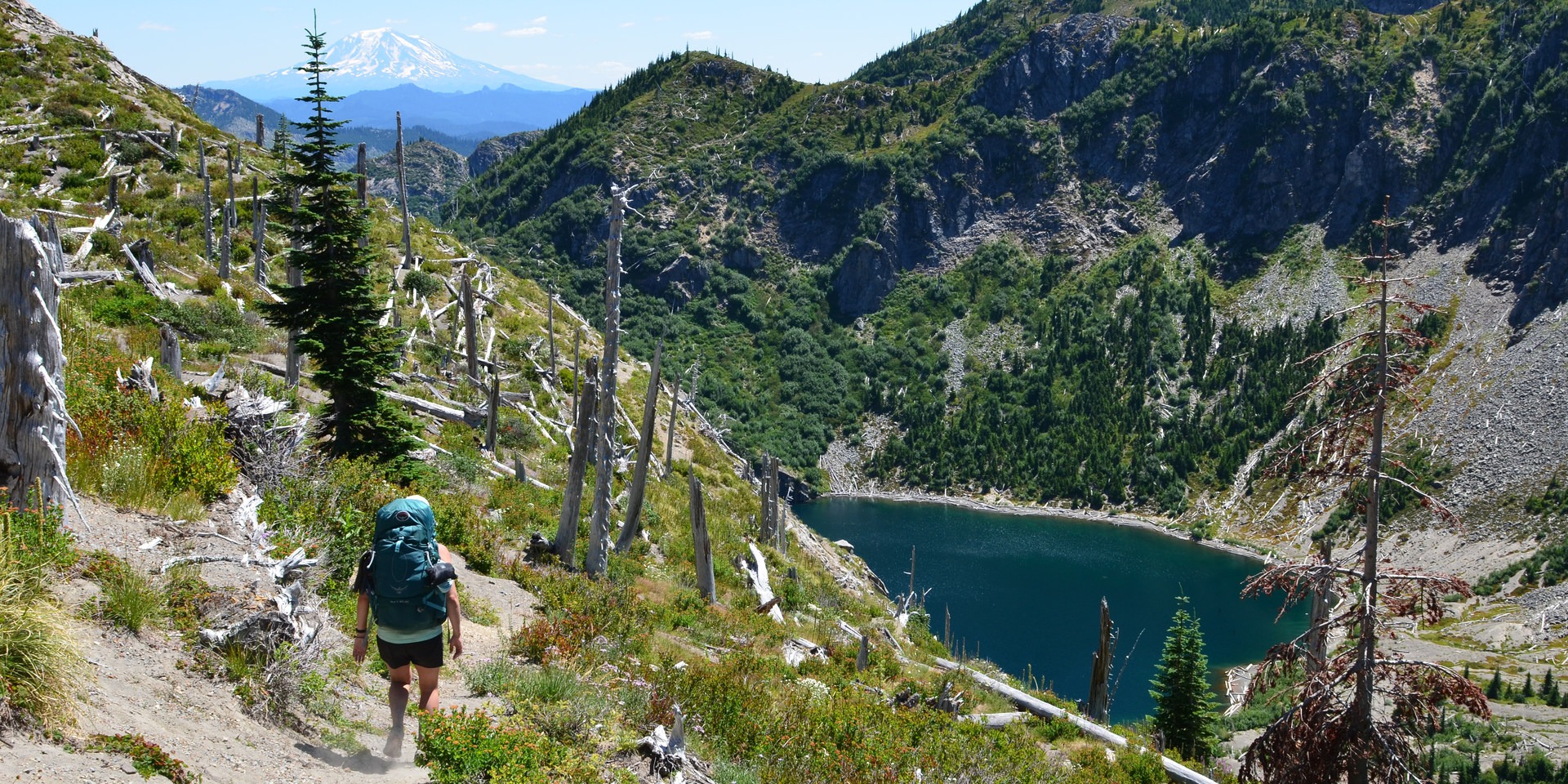You are here
Although Mount St Helens erupted in 1980, the impressive aftermath is still ever present. The Mount Margaret backcountry provides an ominous and humbling glimpse into the power of mother nature. Rugged ridges display completely leveled old-growth forests and erosion. Plant life has made a considerable comeback over the years, however, and a wide variety of wildflowers and vegetation cover the volcanic terrain.
This particular trip focuses on an out-and-back section of Lakes Trail #211 and passes by four pristine lakes, three of which include designated campsites. Beginning at the Norway Pass Trailhead, the dusty ash trail immediately begins climbing Boundary Trail #1 up to Norway Pass, which provides a breathtaking view of Mount St. Helens and Spirit Lake. From here, you’ll head right onto Lakes Trail #211, climbing even higher up to 4,950-foot Bear Pass for unimpeded views of Mount Adams, Mount Rainier, Mount Hood, and Mount St. Helens. Those who would like to make a loop out of this hike can jump onto the Whittier Ridge Trail as well; clockwise travel starting toward Mount Margaret and ending with the Lakes Trail is recommended so that there is more uphill travel in exposed sections. Note that distance, elevation gain, and intense exposure combine to make the Whittier Ridge Trail a serious undertaking that should be thoroughly researched before being integrated into a loop.
You’ll finally begin your decent to a series of log-filled sapphire lakes, the first of which is Grizzly Lake. From Grizzly Lake the trail takes you to Obscurity Lake, Panhandle Lake, and finally Shovel Lake. If vacancies are available, one could plan a multi-day trip that spends a night at each lake. Camping at Shovel Lake involves an additional 0.5-mile descent to the shoreline, yet the scenery is very much worth the extra effort. If you are feeling adventurous, you can avoid an out-and-back by scrambling up to the rugged Mount Whittier ridge to return to Bear Pass. Note that this portion is highly exposed, with sheer cliffs and rudimentary trails.
There are a total of eight reservable backcountry campsites throughout this area, each of which requires a permit and is limited to four campers (Ridge Camp allows eight). Pets and livestock are prohibited in this area to help protect the natural habitat. As a result, wildlife is abundant, and it’s very likely you'll see elk, deer, mountain goats, coyotes, black bear, rabbits, and plenty of eastern brook trout. Wildflowers and berries skirt the trail for much of the late spring and summer. Each clearly defined campsite is outfitted with a level tent pad, grey water sump, and a compostable toilet. Note that water is not present until later in the hike, so it’s highly advised that you carry plenty with you.
Logistics + Planning
Current Weather: Powered by Dark Sky
























Comments
One important update that should also be included on the map and in photos (see attached) is a spur trail junction near where Whittier Ridge Trail meets the Lakes Trail. The spur trail junction is a couple hundred yards above the Ridge/Lakes Trail junction in a small talus field. Multiple travelers we encountered continued on the lesser-used spur trail, which is washed out not far away. People were crossing exposed wash-out on fixed lines that were previously placed, which is not recommended. No portion of the Whittier Ridge trail currently requires ropes in good conditions.
Otherwise, the Whittier Ridge Trail is currently free of snow. There's lots of evidence of trail maintenance by the local Mountain Goat population, but not much else.
All in all, this is one of my favorite trails in the Pacific Northwest. The views are abundant, and there are tons and tons of elk and mountain goats that you'll almost certainly encounter along the way. It is, however, important that you trust your footwork and handholds. The two mile stretch is unrelenting from start to finish, so if you feel uncomfortable in a section, you should know it's not going to get any easier for a while.
But for those who go: enjoy the beauty and solitude-- you earned it!
Sign In and share them.